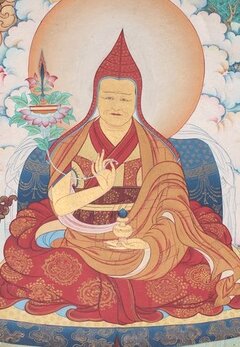Drodung Monastery Guidelines
Drodung Monastery Guidelines
by Katok Shingkyong Jigme Dechen Dorje & Jamyang Khyentse Chökyi Lodrö
Namo guru!
Relying upon them dispels the terrors of existence,
And merely hearing a fragment of their names,
Keeps saṃsāra's dire dominions at bay—
To the three incomparable precious jewels, I bow.
What follows are regulations for the residents of Drodung Sang-ngak Chöling, founded on the site where the Ngupa siddha Chökyi Dorje of the Dharma lineage of the great Shar Katokpa,[1] master of the kama and terma teachings of Ancient Translations, had a vision of vīras and ḍākinīs dancing spontaneously among the pine trees.
As determined by the benefactors, monk-providing areas (grwa rtsa) should supply entrants to the monkhood without decline, and none but these monk suppliers can prevent anyone from entering the monastery.
Teachers should care for new monks skilfully, helping them to master the black and white scripts[2] and memorize the daily recitations (chos spyod) and other essential texts. From the age of ten, monks should take novice ordination, and from the age of around nineteen they should travel to Katok in order to take full ordination. Rituals and daily recitations should be performed according to the traditions of Katok and Orgyen Mindrolling.
During the stricter periods of the summer and winter monks must stay in place for two months at a time. Breaking this rule at either time will be penalized with a fine of twenty gor.
The Praise of the Vinaya says:
Just as the main roots of a tree
Provide a foundation for its growth and all that it bears,
So the basis and source of all aspects of the sacred Dharma
Is taught to be the Vinaya.[3]
Given that the Vinaya is the foundation of the teachings, all novices and fully ordained monks must maintain the five vows: i.e., not to kill, not to steal, not to have sexual relations, not to make false claims about supernatural attainment, and not to consume alcohol. Rules concerning females and alcohol consumption in particular must be strictly enforced at all times. Any transgressions will be penalized according to the written rules.
The rainy season retreat (dbyar gnas; varṣā) and the practice of 'healing and restoration' (gso sbyong; poṣadha) are indispensable, so it is important to learn the ways in which they observed. Learn to write properly according to the best tradition.[4] Intelligent individuals should also train in the outer and inner sciences. Chant leaders, shrine masters and others must learn how to draw maṇḍalas with coloured sand, how to make and decorate tormas, how to perform rituals, how to play the three types of musical instrument (those that are blown, beaten and chimed), and how to chant.
Having long hair is forbidden, as is the carrying of pocket knives. Angry quarrels and fighting will be punished swiftly. Assembly in the monastic hall is required for all but the most incapacitated. You should remain within the monastery compound as much as possible, because wandering at length through the towns and villages of lay people is the root of non-virtue. Set your sights high, therefore, and make the most of your freedoms and advantages.
In short, it is crucial that you adopt and avoid actions according to their effects, that you remain harmonious and share a common purpose, and that you purely maintain both outer and inner vows.
In response to an instruction from Shibcha Tulku Losal, and since we wish to assist in both happiness and suffering and recognise the vital importance of not confusing what should be adopted and avoided,[5] this was written by the Katok throneholder Shingkyong[6] and Jamyang Khyentse Tulku during the month of miracles in the Fire Mouse year (1936).
| Translated by Adam Pearcey with the generous support of the Khyentse Foundation and Tertön Sogyal Trust, 2020.
Bibliography
Tibetan Edition
'jam dbyangs chos kyi blo gros. "bro brdung dgon pa'i bca' yig" In 'jam dbyangs chos kyi blo gros kyi gsung 'bum. BDRC W1KG12986. 10: 537–539. Bir, H.P.: Khyentse Labrang, 2012.
Secondary Sources
Jamgön Kongtrul Lodrö Tayé. Treasury of Knowledge, Book Five: Buddhist Ethics. Ithaca, NY: Snow Lion, 1998.
Jansen, Berthe. The Monastery Rules: Buddhist Monastic Organization in Pre-Modern Tibet. Oakland: University of California Press. 2018.
Kolmaš, Josef. "Dezhung Rinpoche's Summary and Continuation of the "Sde-dge'i rgyal-rabs"". Acta Orientalia Academiae Scientiarum Hungaricae, 1988, Vol. 42, No. 1 (1988), pp. 119-152
Samten Chhosphel, "The Fourth Drime Zhingkyong, Jigme Dechen Dorje," Treasury of Lives, accessed August 28, 2020, http://treasuryoflives.org/biographies/view/Jigme-Dechen-Dorje/8575
Version: 1.3-20250228
-
Dezhung Rinpoche refers to Ngupa Chökyi Dorje's (rngu pa chos kyi rdo rje, 1457–1541?) attainment in his supplement to the sde dge'i rgyal rabs. See Kolmaš 1988: 129 ↩
-
Black script (yig nag) is a popular style of 'headless' (dbu med), cursive script, whereas white script (yig dkar) is a form of 'headed' (dbu can) or block script. ↩
-
Dharmaśreṣthin, Vinayastotra (Toh 4136) ↩
-
Reading lag rgyud as lag rgyun ↩
-
The translation of this line is provisional. ↩
-
Based on the date of the text this would have been the Fourth Drimé Shingkyong Jigme Dechen Dorje (1899–1939?). See Samten Chhosphel, "The Fourth Drime Zhingkyong, Jigme Dechen Dorje," Treasury of Lives. ↩
